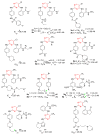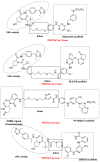The Development of FAK Inhibitors: A Five-Year Update
- PMID: 35742823
- PMCID: PMC9223874
- DOI: 10.3390/ijms23126381
The Development of FAK Inhibitors: A Five-Year Update
Abstract
Focal adhesion kinase (FAK) is a non-receptor tyrosine kinase over-expressed in different solid cancers. In recent years, FAK has been recognized as a new target for the development of antitumor agents, useful to contrast tumor development and metastasis formation. To date, studies on the role of FAK and FAK inhibitors are of great interest for both pharmaceutical companies and academia. This review is focused on compounds able to block FAK with different potencies and with different mechanisms of action, that have appeared in the literature since 2017. Furthermore, new emerging PROTAC molecules have appeared in the literature. This summary could improve knowledge of new FAK inhibitors and provide information for future investigations, in particular, from a medicinal chemistry point of view.
Keywords: FAK inhibitors; PROTAC; anticancer compounds; focal adhesion kinase; medicinal chemistry; pyrimidines; triazines.
Conflict of interest statement
The authors declare no conflict of interest.
Figures









Similar articles
-
Targeting focal adhesion kinase (FAK) in cancer therapy: A recent update on inhibitors and PROTAC degraders.Eur J Med Chem. 2024 Oct 5;276:116678. doi: 10.1016/j.ejmech.2024.116678. Epub 2024 Jul 14. Eur J Med Chem. 2024. PMID: 39029337 Review.
-
FAK inhibitors in cancer, a patent review - an update on progress.Expert Opin Ther Pat. 2024 Aug;34(8):593-610. doi: 10.1080/13543776.2024.2368742. Epub 2024 Jul 2. Expert Opin Ther Pat. 2024. PMID: 38946486 Review.
-
New Insights on Fak and Fak Inhibitors.Curr Med Chem. 2021;28(17):3318-3338. doi: 10.2174/0929867327666201103162239. Curr Med Chem. 2021. PMID: 33143618 Review.
-
Targeting focal adhesion kinase (FAK) for cancer therapy: FAK inhibitors, FAK-based dual-target inhibitors and PROTAC degraders.Biochem Pharmacol. 2024 Jun;224:116246. doi: 10.1016/j.bcp.2024.116246. Epub 2024 Apr 27. Biochem Pharmacol. 2024. PMID: 38685282 Review.
-
Focal adhesion kinase as a cancer therapy target.Anticancer Agents Med Chem. 2010 Dec;10(10):735-41. doi: 10.2174/187152010794728648. Anticancer Agents Med Chem. 2010. PMID: 21214510 Free PMC article. Review.
Cited by
-
PTEN modulates urinary tract infection susceptibility and shapes urothelial antibacterial defenses.Life Sci Alliance. 2025 Jul 23;8(10):e202503292. doi: 10.26508/lsa.202503292. Print 2025 Oct. Life Sci Alliance. 2025. PMID: 40701780 Free PMC article.
-
Matrix stiffness affects tumor-associated macrophage functional polarization and its potential in tumor therapy.J Transl Med. 2024 Jan 21;22(1):85. doi: 10.1186/s12967-023-04810-3. J Transl Med. 2024. PMID: 38246995 Free PMC article. Review.
-
Three-Dimensional-QSAR and Relative Binding Affinity Estimation of Focal Adhesion Kinase Inhibitors.Molecules. 2023 Feb 2;28(3):1464. doi: 10.3390/molecules28031464. Molecules. 2023. PMID: 36771129 Free PMC article.
-
Roles and inhibitors of FAK in cancer: current advances and future directions.Front Pharmacol. 2024 Feb 12;15:1274209. doi: 10.3389/fphar.2024.1274209. eCollection 2024. Front Pharmacol. 2024. PMID: 38410129 Free PMC article. Review.
-
Identification of potential FAK inhibitors using mol2vec molecular descriptor-based QSAR, molecular docking, ADMET study, and molecular dynamics simulation.Mol Divers. 2024 Aug;28(4):2163-2175. doi: 10.1007/s11030-024-10839-3. Epub 2024 Apr 6. Mol Divers. 2024. PMID: 38582821
References
Publication types
MeSH terms
Substances
LinkOut - more resources
Full Text Sources
Medical
Miscellaneous

